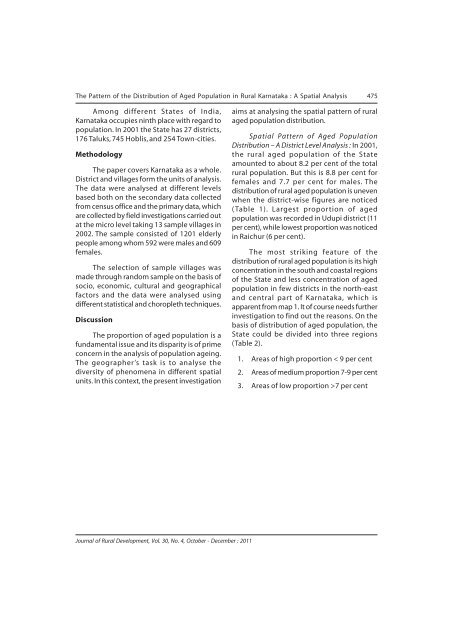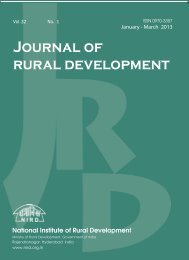474 B.N.Shivalingappa and Sowmyashree K.Land the remaining 11,72,428 (29 per cent) inurban areas. This indicates that majority <strong>of</strong> theaged population were concentrated in ruralareas. This may be due to more out-migration<strong>of</strong> the young people towards the city,decreasing birth and death rates etc. Anothersignificant point is that the proportion <strong>of</strong>females among aged population was more(males 7.7 per cent and females 8.8 per cent),because <strong>of</strong> high life expectancy (males 63.1and females 66.7 years) <strong>of</strong> females.Karnataka has thus witnessedtremendous differences in the distribution <strong>of</strong>old age population between rural and urbanKarnataka. However, these differences are notuni<strong>for</strong>m among all the districts, some districts<strong>of</strong> the State have high proportion <strong>of</strong> rural oldage population, while the others have less ormoderate proportion depending on theregional socio-economic and demographicstructure. It is because <strong>of</strong> this that it is essentialto study the regional variation <strong>of</strong> rural agedpopulation distribution in the State; it helps t<strong>of</strong>ind out the extent <strong>of</strong> concentration, whichmight give a suggestion to the planners andpolicy makers to provide good and necessarypolicies and programmes.The aged population is defined as thosewho are 60 years and above, which is normallyadopted in most <strong>of</strong> the studies. There are manyscholars from different disciplines who havefocused on the concept <strong>of</strong> population ageingat different levels. Leela Gulati (1993) hasconducted a study on population ageing andwomen in Kerala State. The study examinesthe ageing <strong>of</strong> the female population in theState <strong>of</strong> Kerala in the light <strong>of</strong> current and futuredemographic trends as well as the social andeconomic implication <strong>of</strong> this process. Bhim P.Subedi (1996) made a study <strong>of</strong> the geodemographiccontext <strong>of</strong> population ageing inNepal, during the period from 1952 to 1991based on the census and vital statistics. Herevealed that the process <strong>of</strong> ageing <strong>of</strong>population is mainly determined by the trend<strong>of</strong> fertility, mortality and migration. Daksha C.Barai (1997) emphasised the impact <strong>of</strong>population change on older age groups in Indiasince 1901 to 1991 and examined thedemographic causes (CBR, CDR, lifeexpectancy), consequences (dependency, sexratio, labour <strong>for</strong>ce) and related issues. D.P.Singhand Princy Yesudian (2007) made a study on,after age 60 in India from 1951 to 2001, usingsecondary data collected from decennialcensus and NSSO. The study examines thespatial pattern <strong>of</strong> population ageing, both inrural and urban areas in India in the light <strong>of</strong>present and past demographic trends, as wellas the social and economical implication <strong>of</strong>this process.All these studies have concentrated onbroad analysis <strong>of</strong> the process <strong>of</strong> populationageing (growth, pattern, causes andconsequences) at macro level taking statesand countries as a unit <strong>of</strong> the study.The present study is an attempt to focusonly on the rural aged population distributionin Karnataka State taking district as an unit <strong>of</strong>analysis.Objectives <strong>of</strong> the Study : The studyattempts to examine the spatial distributionpattern <strong>of</strong> rural aged population in KarnatakaState at district level, to compare this pattern<strong>of</strong> population ageing with that at the villagelevel.Study Area : Karnataka State lies in thesouth-western part <strong>of</strong> the peninsular India. TheState extends <strong>for</strong> about 750 kms from north tosouth and about 400 kms from east to west.Karnataka’s total land area is 1.91.791 sq kms.It accounts <strong>for</strong> 5.83 per cent <strong>of</strong> the total area<strong>of</strong> the country (32.88 lakh sq kms) and rankseight among the major States <strong>of</strong> India in terms<strong>of</strong> size. As per the 2001 census, the State’spopulation was 5.27 crores out <strong>of</strong> whom 2.68crores were males and 2.58 crores females.Journal <strong>of</strong> <strong>Rural</strong> Development, Vol. 30, No. 4, <strong>October</strong> - <strong>December</strong> : <strong>2011</strong>
The Pattern <strong>of</strong> the Distribution <strong>of</strong> Aged Population in <strong>Rural</strong> Karnataka : A Spatial Analysis 475Among different States <strong>of</strong> India,Karnataka occupies ninth place with regard topopulation. In 2001 the State has 27 districts,176 Taluks, 745 Hoblis, and 254 Town-cities.MethodologyThe paper covers Karnataka as a whole.District and villages <strong>for</strong>m the units <strong>of</strong> analysis.The data were analysed at different levelsbased both on the secondary data collectedfrom census <strong>of</strong>fice and the primary data, whichare collected by field investigations carried outat the micro level taking 13 sample villages in2002. The sample consisted <strong>of</strong> 1201 elderlypeople among whom 592 were males and 609females.The selection <strong>of</strong> sample villages wasmade through random sample on the basis <strong>of</strong>socio, economic, cultural and geographicalfactors and the data were analysed usingdifferent statistical and choropleth techniques.DiscussionThe proportion <strong>of</strong> aged population is afundamental issue and its disparity is <strong>of</strong> primeconcern in the analysis <strong>of</strong> population ageing.The geographer’s task is to analyse thediversity <strong>of</strong> phenomena in different spatialunits. In this context, the present investigationaims at analysing the spatial pattern <strong>of</strong> ruralaged population distribution.Spatial Pattern <strong>of</strong> Aged PopulationDistribution – A District Level Analysis : In 2001,the rural aged population <strong>of</strong> the Stateamounted to about 8.2 per cent <strong>of</strong> the totalrural population. But this is 8.8 per cent <strong>for</strong>females and 7.7 per cent <strong>for</strong> males. Thedistribution <strong>of</strong> rural aged population is unevenwhen the district-wise figures are noticed(Table 1). Largest proportion <strong>of</strong> agedpopulation was recorded in Udupi district (11per cent), while lowest proportion was noticedin Raichur (6 per cent).The most striking feature <strong>of</strong> thedistribution <strong>of</strong> rural aged population is its highconcentration in the south and coastal regions<strong>of</strong> the State and less concentration <strong>of</strong> agedpopulation in few districts in the north-eastand central part <strong>of</strong> Karnataka, which isapparent from map 1. It <strong>of</strong> course needs furtherinvestigation to find out the reasons. On thebasis <strong>of</strong> distribution <strong>of</strong> aged population, theState could be divided into three regions(Table 2).1. Areas <strong>of</strong> high proportion < 9 per cent2. Areas <strong>of</strong> medium proportion 7-9 per cent3. Areas <strong>of</strong> low proportion >7 per centJournal <strong>of</strong> <strong>Rural</strong> Development, Vol. 30, No. 4, <strong>October</strong> - <strong>December</strong> : <strong>2011</strong>
- Page 3 and 4:
Journal ofRural DevelopmentVol. 30
- Page 5 and 6:
Journal of Rural Development, Vol.
- Page 7 and 8:
Promoting E-Governance in Panchayat
- Page 9 and 10:
Promoting E-Governance in Panchayat
- Page 11 and 12:
Promoting E-Governance in Panchayat
- Page 13 and 14:
Promoting E-Governance in Panchayat
- Page 15 and 16:
Promoting E-Governance in Panchayat
- Page 17 and 18:
Promoting E-Governance in Panchayat
- Page 19 and 20:
Promoting E-Governance in Panchayat
- Page 21 and 22:
Promoting E-Governance in Panchayat
- Page 23 and 24:
Journal of Rural Development, Vol.
- Page 25 and 26:
Climate Change and Rainfed Agricult
- Page 27 and 28:
Climate Change and Rainfed Agricult
- Page 29 and 30:
Climate Change and Rainfed Agricult
- Page 31 and 32:
Climate Change and Rainfed Agricult
- Page 33 and 34: 422 A.K. Jain, M. Gopinath Reddy an
- Page 35 and 36: 424 A.K. Jain, M. Gopinath Reddy an
- Page 37 and 38: 426 A.K. Jain, M. Gopinath Reddy an
- Page 39 and 40: 428 A.K. Jain, M. Gopinath Reddy an
- Page 41 and 42: 430 A.K. Jain, M. Gopinath Reddy an
- Page 43 and 44: 432 A.K. Jain, M. Gopinath Reddy an
- Page 45 and 46: 434 S.Mohanakumar, R.VipinkumarIntr
- Page 47 and 48: 436 S.Mohanakumar, R.VipinkumarTabl
- Page 49 and 50: 438 S.Mohanakumar, R.VipinkumarTabl
- Page 51 and 52: 440 S.Mohanakumar, R.VipinkumarForm
- Page 53 and 54: 442 S.Mohanakumar, R.Vipinkumarmuch
- Page 55 and 56: 444 S.Mohanakumar, R.VipinkumarEsta
- Page 57 and 58: 446 S.Mohanakumar, R.VipinkumarTabl
- Page 59 and 60: 448 S.Mohanakumar, R.VipinkumarTabl
- Page 61 and 62: 450 S.Mohanakumar, R.VipinkumarRefe
- Page 63 and 64: 452 B.B. Malik and Jaya Shrivastava
- Page 65 and 66: 454 B.B. Malik and Jaya Shrivastava
- Page 67 and 68: 456 B.B. Malik and Jaya Shrivastava
- Page 69 and 70: 458 B.B. Malik and Jaya Shrivastava
- Page 71 and 72: Journal of Rural Development, Vol.
- Page 73 and 74: Levels of Living of Rural Household
- Page 75 and 76: Levels of Living of Rural Household
- Page 77 and 78: Levels of Living of Rural Household
- Page 79 and 80: Levels of Living of Rural Household
- Page 81 and 82: Levels of Living of Rural Household
- Page 83: Journal of Rural Development, Vol.
- Page 87 and 88: The Pattern of the Distribution of
- Page 89 and 90: The Pattern of the Distribution of
- Page 91 and 92: The Pattern of the Distribution of
- Page 93 and 94: The Pattern of the Distribution of
- Page 95 and 96: The Pattern of the Distribution of
- Page 97 and 98: Journal of Rural Development, Vol.
- Page 99 and 100: Structural, Functional and Situatio
- Page 101 and 102: Structural, Functional and Situatio
- Page 103 and 104: Structural, Functional and Situatio
- Page 105 and 106: Structural, Functional and Situatio
- Page 107 and 108: Structural, Functional and Situatio
- Page 109 and 110: Structural, Functional and Situatio
- Page 111 and 112: 502 Book ReviewsRole of Micro Finan
- Page 113 and 114: 504 Book ReviewsSardar Sarovar Proj
















